Introduction 1
Progressive Thinkers as of 5/8/2020

| page 1 intro | page 2 intro | page 3 intro | page 4a intro | page 4b intro | page 5 intro |
| page 1 | |||||
| page 1b | page 1c | page 1d | page 1e | page 2 | page 3 |
| page 4 | page 5 | page 6 | page 7 | page 8 | page 9 |
| page 10 | page 11 | ||||
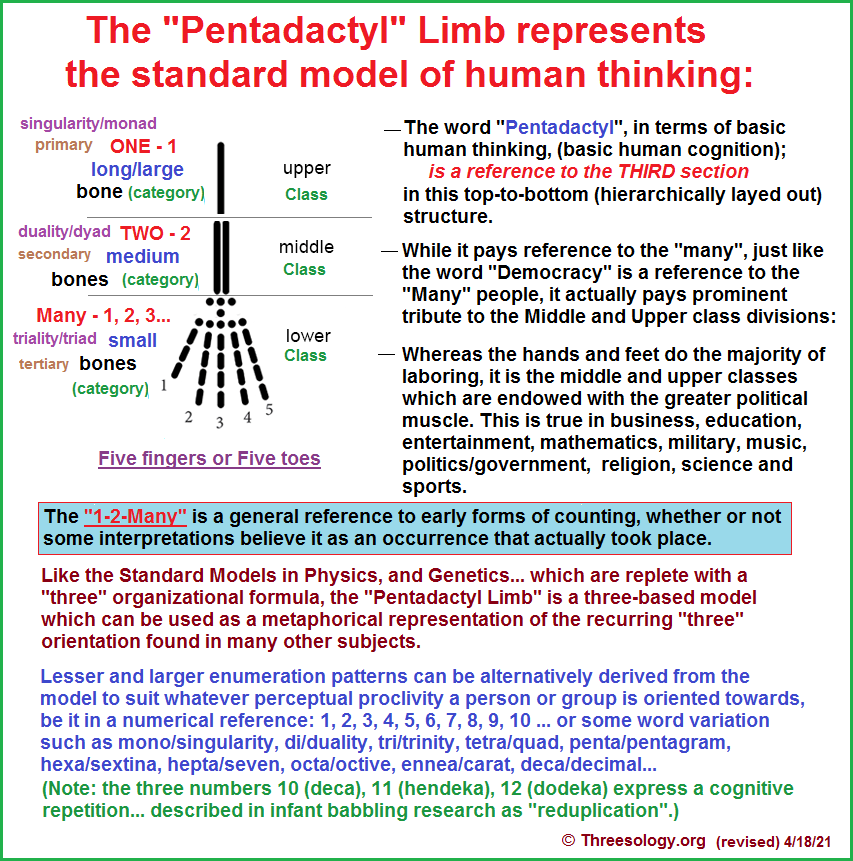
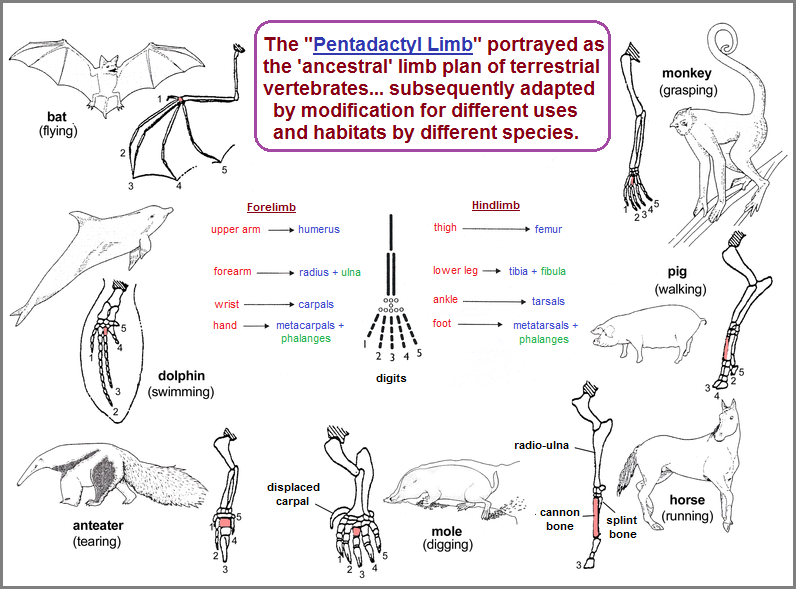
This is actually my second attempt at creating an Introductory page which began a few days ago, since I closed out the page and it didn't save. No recovery program thus far used has produced any results. However, most of the information remains fresh in mind and I need only to recreate what I can, albeit in a different order. I begin the Introductory page almost two years after beginning this series, knowing all too well that I have attempted to create an introduction to stand as the Home page, yet the Home page of this site may need some other formulaic representation. Nonetheless, let me begin anew by once again referencing the Pentadactyl limb as representing what I believe to be a schematic of cognitive activity to be found in other subjects. The Pentadactyl limb reminded me of the sociological divisions of upper, middle and lower classes with the metaphorical distinction that the upper class... represented by the attached larger arm and leg muscles, comparably suggesting that it had greater "political muscle".
I recall now that in the previous draft I made a momentary excursion into providing the rationale for a research focused document to include a personal note concerning one or another discrepancy involving some social circumstance that is being woefully overlooked. In the present venture I want to momentarily discuss the absurd usage of funds for those incarcerated in prison which is a model of babysitting, and the disgusting lack of concern for funding daycare centers for working moms and dads. On the one hand we spend 80+ billions of dollars to warehouse prisoners... many of whom are just statistics of recidivism waiting to happen, and yet do not provide publicly funded daycare for our children who make up the future of the country with all its desired and proposed hopefulness. While such personal regards are not typical for a research document, there are far too many absurd hypocritical injustices taking place for researchers to stand idly by. It should be standard practice for researchers to post a sociological monologue about some condition which needs to be addressed.
The idea of a "Standard Cognitive Model" takes many forms from the vantage point of different researchers who may be otherwise unaware that others have reached a conclusion involving some recurring pattern that is viewed as a commonly accepted reality amongst their ilk in a given research area. The circumstance is much like a social stratification system where different classes of researchers are oblivious to the cultural practices and orientations of other classes unless they cross those barriers which may cause separate spheres of isolation; be it due to differences in vernacular, academic association, or other socio-economic/demographic participations which may induce one or another limitation for broadening one's overall perspective. Such a broadening may well involve providing for the allowance that one's particularized research model's labeling and application is not a "THE" pristine fundamental representation; but is more along the lines of being a generality or even metaphor that one might apply the words shadow, echo, scent, feeling, transitory impression, subtle abstraction, etc... to as an inference. While some researchers may want to insist that the labels used in their particularized model is sacrosanct, inviolable, and distinctly basic, fundamental and an originating genesis for which there exists no clearer or cleaner representation; the truth of the matter is that all of us may be dealing with induced familiarities we are inclined to adopt as keynote emblems of a foremost substrate similar to the notion that there is no more fundamental particle to be found below or inside that which one is presenting as a foremost primary model. However, irrespective of the possibility that different researchers may use different labels to describe a basic cognitive pattern, it is of interest to note that when a numerical reference is applied, we see the same enumeration as our own. Take for example the following research model dealing with both numbers and human cognitive activity:
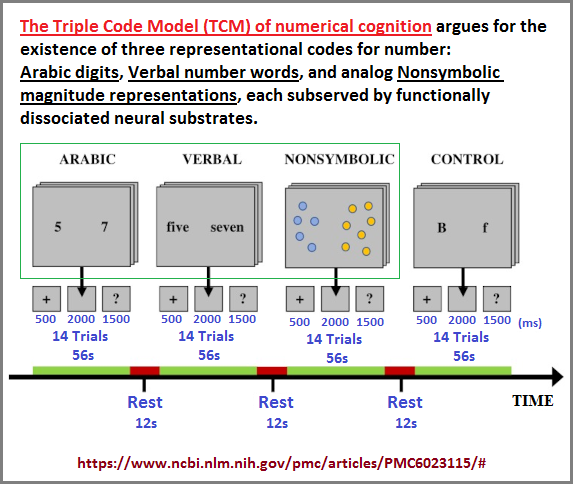
In making a comment about how different researchers from different backgrounds may well perceive and illustrate a similar pattern, the differences in perception and application within the context of a particular research focus (ideas which are widely accepted among colleagues and those which may not even have come to mind or at least rarely if ever mentioned); can be organized in a sociological frame of reference such as a White collar- Blue collar- No collar (t-shirt) segmentation, though one might venture to explore the usage of a psychology-based organization using the old Freudian markup of Superego- Ego- Id as loosely bound correlates. While some observers may claim that each division has it own "veneer" which separates the categories, we should mention such an idea in the context of intellectual dispositions. For example, the intellecutalizations used by academic or industry trained thinkers whose primary interest is to further knowledge can be different from the "mental vernacular" of someone whose orientations are sociologically supported in a routinized work environment where the primary objective is to make money; which can also be contrasted with those whose mental vernacular is primarily concerned with day-to-day... hand-to-mouth survival concerns. Indeed, differences between these three may not have the occasion to explore the vantage points of the others unless by choice, accident, or combinations of choice and accidental exposure. In any case, the result may produce an individual who no longer actually fits comfortably in any singular category and therefore creates an offshoot that is enabled to trespass, transgress, of find some form of transmission between relatively existing different occupations. Whereas one is not fully accepted in any specific category, they are nonetheless able to garner useful information that is valuable to all three segments, and are able to translatably convey such information with the appropriate terminology. An old colloquial expression about this circumstance is relayed as "Different Strokes for Different Folks".
While the foregoing Triplet Code Model illustration's information is not entitled a "Standard Cognitive Model" or "Body plan" (Bauplan) or even more loosely referred to as an "Archetype" of cognitive activity, it clearly represents these notions. However, the authors of the study do not attempt to go into providing similar triple patterns found in different subjects in order to provide the reader with the vantage point of realizing that the basic numerical value of such a pattern similarly exists in different structural occurrences in multiple other subjects which provide the quantity of examples that would at the very least suggest such a pattern is not only not a coincidence, but may have an originating impetus outside physiology... where physiology is the medium through which the impetus is expressed according to a recurring structural compartmentalization... similar to the manner in which the biology of different species react to the same environmental pressures within the scope of their physiological ability... or lack their of. In this sense, the cognitive occasions for a three-pattern may well be a further expression of the three germ layer developmental theme being repeated like some reverberation or successive emanations viewed as a response that one may provide the image of a pebble being dropped in a pool of water where repeating concentric circles "echo" or shadow one another as surface vibrations. In this sense, cognitive expressions of repeating numerical references are occasioned by a physiology already attuned to the process of triple variations such as:
- Developing on the third planet (Earth)
- By way of a triplet code in Atoms
- Then a triplet code in DNA/RNA/Proteins
- Followed sometime later by a triplet code in molecular bonds
- Then a "triplet code" of Germ layer development;
- For which we later recognize a physical architectural plan of threes: List of threes in human physiology,
- and thus later by multiple ideas in different subject areas where a pattern-of-three may play a dominant observance (such as a Trinity or Triad or Triangle or Triple Hierarchy in Philosophy, Religion, Metaphysics, Sociology, government structure, etc.), though other (typically small number) pattern formulations may be distinguished as attributions as well.
In addition to those items listed above to which we could add the "threes" structures of hearing and the "threes" structures of language/linguistics (and "threes" structures of grammar); one may note the idea of three dimensions and the current idea that there are three models of the Universe routinely expressed as Flat, Spherical, and Saddle-shaped, to which I imaginatively label as linear, circular, and triangular.
Whereas some readers may be quick to point out there are other-than-three patterns such as patterns-of-one, two, four, five, six, seven, eight, nine, etc., these same observers don't include the reality that most patterns are low or small numbers, thus representing a conservation for the whole, or that in multiple cases some notion of a third (or second or fourth...) item is termed with the "many" value, which can readily be often viewed as the third item in human cognitive assessments of multiple items. For example, we notice a typical 9/2 arrangement of microtubules with an underlying arrangement of a triple structure, yet when giving an example of the axoneme of an axopodium, we note the array may be from three to many, depending on the species, as illustrated in the following image:

When speaking of microtubules it should be noted it is one of three important structures:
Three major types of filaments make up the cytoskeleton: actin filaments, microtubules, and intermediate filaments. Actin filaments occur in a cell in the form of meshworks or bundles of parallel fibres; they help determine the shape of the cell and also help it adhere to the substrate. The constantly changing arrays of actin filaments help move the cell and mediate specific activities within it, such as cell cleavage during mitosis. Microtubules are longer filaments that are constantly assembling and disassembling; they play a crucial role in moving the daughter chromosomes to the newly forming daughter cells during mitosis, and bundles of microtubules form the cilia and flagella found in protozoans and in the cells of some multicellular animals. Intermediate filaments, in contrast to actin filaments and microtubules, are very stable structures that form the true skeleton of the cell. They anchor the nucleus and position it within the cell, and they give the cell its elastic properties and its ability to withstand tension. ("Cytoskeleton" (2013). Encyclopædia Britannica.)
In the present observation of a Standard Cognitive Model using a Pentadactyl Limb illustration as a visual medium of supporting different idea found in multiple subjects; the designated quantity of bones representing (from top to bottom in this illustration... though one might easily turn the image in different directions); the values of one bone, two bones, and many bones, is use to reference the notion of a basic developmental counting scheme where early humans first developed a concept of "one", followed sometime by a "two" concept, but that in each separate case, the next quantity was "many," though ideas such as heap, much, more, a lot may have been the linguistic equivalent for a given group of human counters. However, it should be noted that enumeration appears to have come after the usage of geometric representations, of which early numerical symbols such as a line intimated the future usage of it to display the quantity of "1". While stick figures need not have been used in all cases as the singularly most used model for illustrating quantity, the idea that geometric figures preceding discrete symbols used for numbers is not difficult to conceptualize as a possibility if not probability.
In other words, upon reaching the count value of "one" derived from pairing, all other values would have had some notion of many... that we of the present assign with the word "infinity". When the value of "two" became cemented in consciousness, all other counts more than this was again assigned the value of "many", irrespective of the word or assumption actually being used. At each cognitive point there came a stop-gap exercise that may have lasted several generations or only a short while. In any case, the phrase "one- two- many" can be used as a general statement reflecting developmental counting systems, even if they did not actually occur in this manner. Some groups may have grasped number values exceedingly fast, whereby they reached the value of 10 before considering larger numbers to be "many". Again, a one-for-one pairing appears to be a regularly used developmental procedure in human thinking processes. Even after the value of ten we find a repetition of the pairing method in that a type of "one plus ten" expression gained favor, and that the present day words twelve, thirteen, fourteen, fifteen, sixteen, seventeen, eighteen, nineteen, and twenty, still retained this same pairing usage that has been fused together into a single word. Hence, the "teen" is ten. The "twenty" is two tens, and so forth.
It is not customary for us to find old counting systems which do not involve some measure of repetition. In writing the value "10" we repeat the usage of a zero and one. Even the value "2" was commonly represented with a repeat of the singular "1", such as placing two lines or sticks or shells, etc., together. Nonetheless, we humans make usage of a system involving what we describe as ten different symbols which includes the zero. Repetition is a recurring cognitive theme expressed with the phrase "Monkey see, Monkey do". Indeed, the present design of society is to create institutions so that repetition takes place such as in schools and workplaces. Instead of calling repetitions as mimicry or do-overs, we may use the words habit, routine, or chore, if not some other similar reference. Yet, the point to make is that we do find recurring practices that we may label as a commonality, as being typical, or usual, or as a rhythm, or representing a standard practice, such as is often cited as an excuse to be used against a public when attempting to confront a self-serving business environment wanting to make gains by taking advantage of people. The phrases "standard business practice", "standard industry practice" is used as a supposed defensible reason to effect practices which routinely are not in the best interest of the public, but are permitted to be exercised by enforced government legal allowances due to a government that routinely adopts a similar practice to force people to comply, despite the many inequalities which exist. In short, we find multiple exercises of standard activity in social practices which are often taken for granted. The idea of a "standard cognitive model" is just a label referencing the observation of recurring appearances of mental activity exhibiting a given pattern that is not meant to convey a solely explicit strict model, other than to bring to the fore of observation that such a pattern occurs too often to be a coincidence... unless one's standard for defining a coincidence permits hundreds of occurrences to take place.
Anyway, the Pentadactyl limb illustration reminded me of the one- two- many counting theme which I have found being exhibited in different subjects as an expressed three-patterned ensemble. Like the Pentadactyl limb being used to illustrate a common architectural structuring found in multiple life forms and called a basic body plan (Bauplan), it suggested to me that it could be used to illustrate the presence of recurring cognitive patterns that I initially phrased as a "Standard Cognitive Model", but need to emphasize that this singularity should be read in a plural sense, since multiple cognitive patterns can be identified but that the assortment is rather limited, much in the manner that we pay witness to the limited quantity of elements in the Periodic table, or the limit of planets in the present solar system, or the limit of singular numbers and letters as well as the limited resources available on Earth with its limited life span. Though some would insist that there are multiple-many cognitive patterns, they typically do so from the perspective of using word labels which are more variable than when using enumeration... even though there is considerable "fudging of numbers" in subject matter designated as providing a greater level of truth because it relies on numbers and not words which can be multiply interpreted depending on context and personal motivations.
Whereas some may want to argue that the "one-two-many" or "1-2-3" patterns are not the only patterns to be observed, and thus say that other patterns constitute the necessary rationale for being dismissive of such patterns as having any value in describing a supposed standard cognitive pattern, they fail to include the limitations of the overall patterns being used in a routine fashion in multiple subjects. While it is easy to say that quantities of millions, billions, trillions refute the notion of a recurring three pattern as a dominant standard, they overlook such a pattern as an ensemble of three itself. Whereas we do not find larger quantities being routinely exhibited in the patterns being expressed by different researchers in different subjects, it is the case where larger quantities may be grouped as a "many" expression, such as when we routinely create sets of three followed by a comma in mathematics and or interjected by in a grammatical sentence where three examples are being provided, though in a group of three examples one may use the "and" as the preferred comma otherwise noted as a point of demarcation. A millions-billions-trillions expression is a three-patterned ensemble representing a consistency of an assumed standard cognitive pattern, though the linguistic expression otherwise says "many".
In counting the quantity of bones, some readers may prefer to itemize the quantities of bones found in the hands and feet, that... by the way, are viewed as representing the lower class and the middle (forearm) bones representing a go-between link between the upper and lower classes. Interestingly, in my correlation of the hands and feet as representing the lower class, we find that such articulations do most of the work and often require the added protective support by way of shoes/boots and gloves, though the use of goggles for the eyes and hearing protection of the ears need to be mentioned so as to acknowledge additional protections for them in many daily work occupations, while other parts of the body receive protections typically only when in the context of some sport. The "added" protection in a sociological sense is put into place by protectionist laws and government programs specifically designed to reduce the very many inequalities and partialities existing in societies throughout the world. Whereas government policies are meant to protect the lower and middle classes from the voracious predations of the upper class, the middle and lower classes use the upper class as its role model and thus create a dog-eat-dog way of life very near to the practices of a distant past exhibited by canines. Yet, only through riot and protest do the people have a means to defend itself against predatory government practices because no true Peoples Legislative Branch exists which functions in a jury-duty fashion against Legislative bodies.
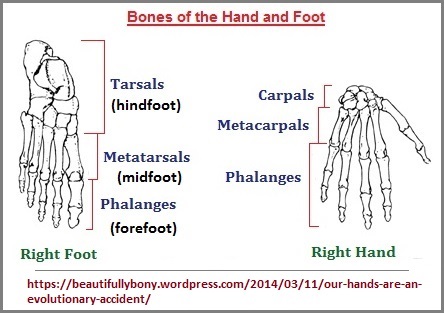
It is of some interest to note that the bones of the hands (27 x 2) and feet (26 X 2) equa1 106 bones, which is over half the total skeletal quantity of 206. Let us take a look at the lineup of these two functionalities:
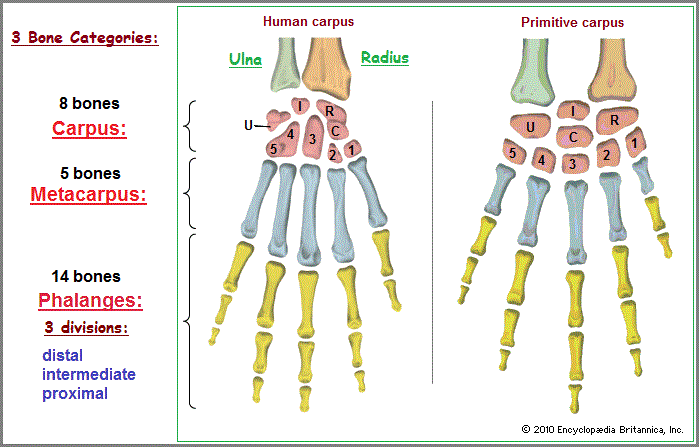
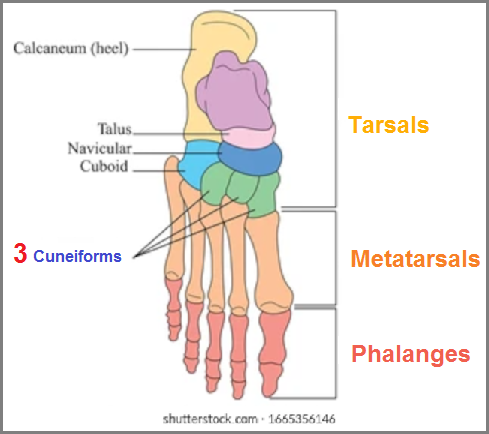
While I reference the quantity of bones in each of the appendages as "many" because its generality can accommodate comparisons with other labels such as plurality, poly, manifold, multitude, myriad, a lot, plenty, numerous, etc., several, various, infinity, heap, hundreds, thousands, millions..., and-so-on, Universe, forever, vastness, group, cluster, horde, herd, flock, congress, divers, gang, army, (opposite of monism---1, is said to be dualism---2), etc., etc., etc... Note, even the so-called one god is sometimes represented with three thematic definitions expressing much or many or all: Omnipresent, Omniscient, Omnipotent. Large numbers or large quantities are frequently used as an expression of "many" or much in different contexts, while specific values may be used as a similar reference, though a person may not be conscious of their reliance on a given number or expression as representing their personalized expression of "Many". For example, the U.S. Presidential seal has the inscription "E Pluribus Unnm". When translated it means "Out of Many, One." Hence, in this circumstance we have only a set of two enumerations: One and Many. And in the colloquial expression about someone being intoxicated, we find "one, too, many". Stated fully as "They've had one, too many to drink." The "too" in this case clearly rhymes with and represents the value of "two."
The use of the label "many" is useful when other researchers do not use enumeration in their illustrated sequences for distinguishing characteristics of information which is grouped. However, all information on a given topic may not be grouped and remain as a cluster of individually assigned characteristics, whereby a "many" or much/more situation is expressed as if one is somehow dealing symbolically with a type of personal wealth. By retaining a collection of singular identities of (persons-places-things), this may take on the perspective in some views of having more than is actually present. For example, if one is meant to count seconds, a minute can appear take a much longer time than if one is calculating minutes. Another example is the countdown of rocket taking off. The sequence of 10-9-8... does not speed up, but may actually creating the psychological disposition where time appears to take a slower pace than if one is momentarily distracted from mentally itemizing the enumeration. However, a researcher may well use enumeration even though one or more of a set may actually involve a larger subset that can be included, but does not reach a point of expression except in private or isolated cases of research. Other researchers may be privy to additional circumstances while the general public is provided with a simplified view.
While I use the general term "many", I also rely on enumeration to identify recurring themes of human cognitive activity. However, if we were to include every single variable due to differences in personal preferences of perception, we end up with a collage or montage of what may appear to be a confused organization representing an incorporated "many", with a great difficulty in deciphering the presence of enumeration because of a general public penchant for viewing observations from an artistic vantage point aligned with a vagary of emotions. The usage of generality is sometimes useful when dealing with multiple subjects where the concern for multiplicity takes the forefront of expression so as to give someone the impression of some supposed limitless creativity.
Since it is easy to recognize human thought patterns reflecting events in nature such as the variety of two-patterned ideas found in the Yin/Yang profile of opposites which are frequently viewed by some as complements which can compliment one another; some readers may be quick to identify such things as hot/cold, day/night, winter/summer, and various terrains which reflect stark differences from one another. Others might consider that the two-patterned bipedal gait of humans inclines them to "naturally" think in a symmetrical back and forth, side to side, up and down series of motions, which would explain why humans tend to think in contrasts called duality, dichotomy, etc... Yet, though there are multiple patterns-of-two arrangements with the human body and various ideas are similarly two-patterned, there are also groups and functionalities occurring in patterns-of-three. Indeed, if we look at the general layout of the human body and use enumeration, we find the macrosopically observable following:
- ONE head, tongue, nose, penis, vagina, butt, mouth, jaw, stomach, chest, back
- TWO eyes, ears, nostrils, testicles, breasts/nipples, arms (elbows, forearms), legs (knees, shins, calfs, thighs), jaws (sets of teeth), hands (thumbs, pa;ms), feet (toes, heals, souls), hips,
- THREE arm and leg joints, finger and toe divisions, eye: cornea/iris/pupil
- FOUR limbs, fingers (minus toes and thumbs because they have different labels)
- FIVE/TEN/TWENTY fingers, toes
- THIRTY TWO teeth
And yes, we can observe more body parts and body activities if we engage in dissection as well as resorting to bio-chemistry. However, we find that larger numbers are infrequently used, though some people may group kinds of items such as organs together or cells, or quantities such as blood, etc... For example it is guesstimated that the human brain has 100 billion cells. Interestingly, it is said that by averaging the types of stars in our galaxy represents the quantity of stars in the Universe as being 100 billion. Are the two similar counts a coincidence or an exercise in a cognitive expression of "many"? Interestingly, the human body has been used by different cultures as a kind of accounting tablet in which different parts are used to reference different values. Examples are the ancient Egyptians with 3 (heel bone = 10, finger = 10,000, man with hands over head or outstretched = 1,000,000 )and he Papua New Guineanians with a 27 body-part counting system. The ancient Egyptians also used the eye of Horus to illustrate fractions.
Here are some everyday (colloquial) expressions involving number and body parts:
- ONE
- single-minded
- TWO
- two-faced/Janus-faced, forked tongue, split personality, bipolar, 2 front teeth: buck-teeth ("All I want for Christmas is my two front teeth.")
- THREE
- third eye (said to belong to insightful individuals and sometimes referred to as the minds eye)
- third ear (said to belong to gifted musicians)
- third hand (holding items with one's mouth)
- third molar (alternatively called a wisdom tooth)
- three finger designations: middle eastern eating technique, writing with pen or pencil, computer "3 finger salute": control/alt/delete keys
- third finger "salute" (middle finger used as an offensive gesture representing the two-word phrase "fuck you" or "fuck off")
- three legs: uses a cane
- FOUR
- four-eyed (wears glasses)
- FIVE
- five-finger discount (theft)
Date of (series) Origination: Saturday, March, 14th, 2020... AM
Date of Origination (this page): Saturday, 5th March, 2022... 4:28 AM
Date of Initial Posting (this page): Wednesday, 16th March, 2022... 1:52 PM